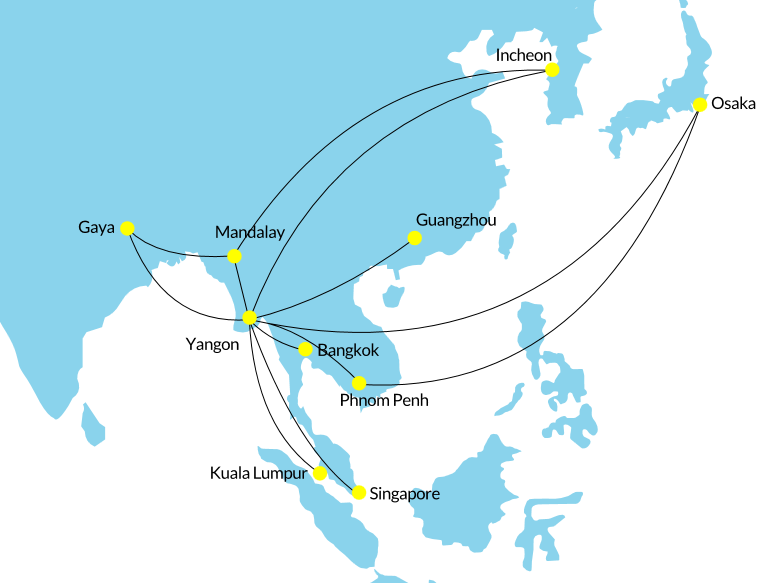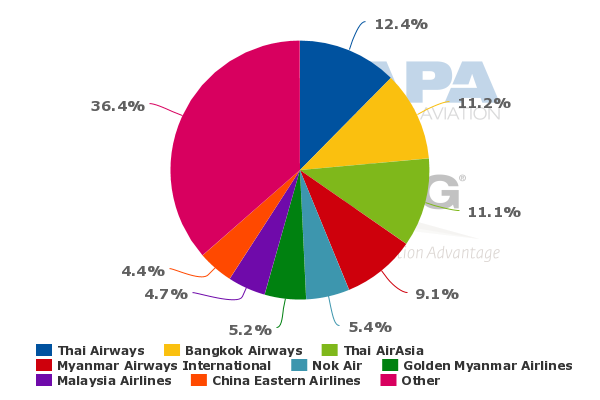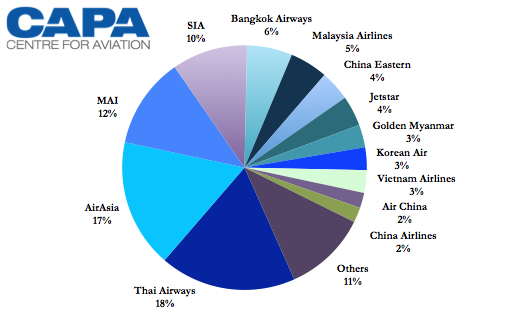Myanmar Airways International starts a new expansion phase with Seoul and Osaka services
Myanmar Airways International (MAI) is pursuing expansion in North Asia with new services to Osaka and Seoul. The expansion increases the airline's network to eight destinations and approximately doubles its weekly ASKs, pushing up its small share of Myanmar's fast growing but highly competitive international market.
The expansion will position MAI to potentially benefit from rapid growth in Myanmar's tourism sector. MAI, which became entirely privately owned in 2013, has not yet participated in the huge growth Myanmar's international market has enjoyed since the country opened up in 2011.
MAI risks being squeezed out if it does not grow. But its upcoming expansion is also risky as MAI will compete in the Korea and Japan markets with larger foreign carriers and eventually Myanma Airways, a government-owned domestic carrier, aiming to launch services to North Asia in 2015.
 |
CAPA's Asia Aviation Summit and LCC Congress will he held at the Capella, Sentosa in Singapore 13/14 October, followed by a Corporate Travel Day on 15 October. To hear from Myanmar's airlines and learn about China's new LCC movements as well as the latest on all of Asia's key aviation markets and players, and meet 20 airline CEOs, click here: CAPA Asia Aviation Summit |
MAI currently only serves five international destinations
MAI is one of nine airlines in Myanmar (soon 11 as two more are about to launch operations), but is the main international carrier. MAI is almost entirely an international operator and currently serves five destinations - Bangkok, Kuala Lumpur, Singapore, Guangzhou and Gaya in India.
Osaka Kansai will become MAI's sixth scheduled destination and first destination in Japan on 8-Oct-2014. MAI plans to initially serve Osaka with three weekly non-stop flights from Yangon. On the return from Osaka to Yangon the flight will stop in Phnom Penh, giving Japanese tourists the opportunity to combine Cambodia with Myanmar.
The Phnom Penh stop marks another resumption of service to Cambodia for MAI. The carrier initially re-entered the Cambodian market in 2012 with a circle routing to Phnom Penh and Siem Reap but dropped Siem Reap in 2013 and suspended Phnom Penh earlier this year.
MAI network map: as of end Oct-2014
Seoul Incheon will become MAI's eighth scheduled destination on 26-Oct-2014. MAI plans to initially operate five weekly flights to South Korea on a Yangon-Seoul-Macau-Mandalay-Yangon routing. Macau is a technical stop while Mandalay is part of the route as tourists visiting Myanmar typically combine Mandalay and Yangon.
MAI faces increasing competition from other Myanmar airlines
Yangon-Mandalay is MAI's only domestic route and is operated as part of a sector on some of its existing international flights. Six of Myanmar's other carriers are entirely domestic while the other two, Air Bagan and Golden Myanmar, are primarily domestic with only one or two international routes. But several of the domestic carriers are now aiming to expand into the international market.
The most ambitious international expansion is being planned at Myanma Airways, which operates regional aircraft on domestic routes but committed in early 2014 to leasing six 737-800s for delivery from Jun-2015. As CAPA previously outlined, Myanma Airways is planning to operate its future fleet of six 737-800, three of which are slated to be delivered in 2015, on new routes to North Asia. (Myanma Airways also has committed to leasing four 737 MAX 8s, which will be delivered late this decade).
See related report: Myanma Airways to pursue major government-backed international expansion following 737 GECAS deal
MAI's decision to launch Korea and Japan services in Oct-2014 can be seen as a competitive response ahead of Myanma Airways' international launch and rebranding, which is expected to be completed before the carrier ventures into the international market.
Myanma Airways helped establish MAI in 1993 and at the time exited the international market. Myanma Airways has since only operated domestic services. But the government is now keen for the carrier to resume international services and aid efforts to attract more international tourists.
Myanma Airways sold its stake in MAI in 2013 to one of Myanmar's largest private banks, Kanbawza Bank, paving the way for international expansion. Kanbawza already owned one of Myanmar's domestic carriers, Air KBZ, and had a majority stake in MAI. The KBZ Group initially acquired an 80% stake in MAI in 2010 and now owns 100% of the carrier.
Myanma Airways is not the only new competitor for MAI. While the prospect of more competitors to North Asia is not likely, several of Myanmar's carriers have been looking to enter the regional international market. For example domestic turboprop operator Air Mandalay has acquired ERJ-145 regional jets which it plans to operate on international routes prior to the delivery of its recently ordered Mitsubishi MRJ90 regional jets.
See related report: Myanma Airways ATR 72-600 and Air Mandalay MRJ90 orders further escalate battle for Myanmar market
International expansion for Burmese carriers is critical as Myanmar's domestic market is limited and extremely competitive. Myanmar's domestic market consisted of only 3.8 million passengers in 2013. The domestic market is growing, including by 8% in 2013, but not as fast as the international market (32% in 2013) and not enough to support 11 airlines.
The upcoming launch of services from start-ups FMI and Apex will add further pressure to Myanmar's domestic carriers, none of which are believed to be profitable. FMI has acquired CRJ200 regional jets while Apex has leased ATR 72s. Both carriers will initially operate domestically but have international ambitions.
MAI traffic and market share have been on the decline
Regional destinations within Southeast Asia, in particular Bangkok, Kuala Lumpur and Singapore, have traditionally been MAI's staples. Competition has already intensified on these routes over the past two years, driving down MAI's market share.
MAI transported only 312,000 international passengers in 2013, a decline of 17% compared to 2012, according to Myanmar DGAC data. MAI only captured a 12% share of Myanmar's international market in 2013, down from a 19% share in 2012.
Bangkok, Kuala Lumpur and Singapore accounted for over 90% of MAI's traffic in 2013. But its traffic in all three markets dropped as competitors expanded.
Over the past two years MAI has reduced frequencies to Bangkok, Kuala Lumpur and Singapore while all other competitors have added capacity and in some cases entered the Myanmar market. MAI currently operates two daily flights to Bangkok, 10 weekly flights to Singapore and two weekly flights to Kuala Lumpur, according to OAG data.
MAI competes against five airlines in the Yangon-Bangkok market - Bangkok Airways, Thai Airways, Golden Myanmar, Nok Air and Thai AirAsia - which currently have a combined 94 weekly flights. MAI's capacity share in the Yangon-Bangkok market is currently only about 10%, compared to about 14% one year ago, according to CAPA and OAG data
Golden Myanmar, Jetstar Asia, Tigerair, Singapore Airlines, SilkAir currently compete against MAI on Yangon-Singapore and operate a combined 67 weekly flights. Malaysia Airlines and AirAsia each serve Yangon-Kuala Lumpur with two daily flights. MAI's capacity share in the Yangon-Singapore market is currently about 19% while on Yangon-Kuala Lumpur it is currently only about 7%.
MAI also operates three weekly flights to Guangzhou and three weekly flights to Gaya (based on schedules in OAG for the week commencing 29-Sep-2014). MAI carried about 25,000 passengers between Yangon and Guangzhou in 2013 and about 25,000 passengers between Yangon or Mandalay and Gaya.
Yangon-Guangzhou was launched by MAI in late 2010 and is also served by China Southern. MAI has served Gaya for several years and competes on the Yangon-Gaya route against Air India. Gaya is a popular religious pilgrimage destination for Buddhists and is typically served on a seasonal basis.
MAI currently accounts for about 9% of international seat capacity in Myanmar, according to CAPA and OAG data. Its share will again exceed 10% at the end of Oct-2014 after services to Korea and Japan are launched.
Myanmar international capacity share (% of seats) by carrier: 29-Sep-2014 to 5-Oct-2014
The two new routes will result in about a 25% growth in seats and a doubling in ASKs. Several foreign carriers are also adding capacity in Oct-2014 - although this is mostly seasonal adjustments for the peak season and in most cases does not represent entirely new flights.
See related reports:
- Myanmar international aviation outlook: after two years of rapid expansion, growth starts to slow
- Myanmar international airline market suffers from growing pains. Has capacity been added too fast?
MAI faces uphill battle in Japanese market
MAI currently operates a fleet of three A320s and two A319s with an average age of 18 years, according the CAPA Fleet Database. As MAI has older model A320 family aircraft it generally lacks the range to operate non-stops from Korea or Japan to Myanmar without payload restrictions. Eastbound flights from Yangon can operate non-stop as they are about one hour shorter due to tailwinds.
ANA is currently the only carrier in the Myanmar-Japan market and operates a daily service from Tokyo Narita to Yangon using 767s. MAI will not compete directly with the Japanese carrier because at least for now it will only serve Osaka. (Additional Japanese destinations will be considered as MAI plans to focus on North Asia as it looks to further expand its international network.)
ANA offers connections to Osaka but several Asian carriers offer equally or more convenient connections in the Osaka-Yangon market. MAI could find it challenging to gain traction in the Japanese market as it is an unknown brand. Offering Mandalay as a stop could be an advantage but the technical stop in Macau is an inconvenience.
A few Asian carriers also already offer one-stop connections in the Osaka-Mandalay market. Most foreign carriers including ANA only serve Yangon but frequent connections are available between Mandalay and Yangon on all of Myanmar's domestic carriers.
MAI to start competing against two codeshare partners in Asiana and KAL
MAI will face more direct competition on the Yangon-Seoul route. Korean Air (KAL) and Asiana both launched services to Yangon in late 2012.
KAL currently offers one daily flight on the route (using A330s during the northern winter months and 737-800s during the summer) while Asiana operates only two flights per week (767s year-round). MAI will have about a 27% share of capacity from Yangon to Seoul during the peak winter season while KAL will have about a 56% share (once its flight transitions back to the A330) and Asiana will account for the remaining 17%.
Yangon to Seoul capacity by carrier (one-way seats per week): 10-Sep-2012 to 29-Mar-2015
MAI has been codesharing with both Asiana and KAL, giving it some exposure to the Korean market. Competing with both carriers will be challenging as the Myanmar-Korea market consists almost entirely of inbound tourists. Asiana and KAL have the relationships with Korean agents and the scale to outmuscle new smaller competitors.
The stop in Phnom Penh on the Seoul-Yangon sector will give Korean travel agents the opportunity to combine Myanmar and Cambodia. But most passengers will likely fly through as tourists heading to Cambodia typically combine Cambodia with Vietnam or Thailand. The stop could be seen as an inconvenience as KAL and Asiana serve Yangon non-stop in both directions.
The future of its partnerships with Asiana and KAL could also be jeopardised as MAI launches its own Seoul service. As MAI is not a domestic carrier, Asiana and KAL could be better off partnering with another Myanmar carrier that does not compete on Seoul-Yangon and would be able to offer domestic feed.
Potentially losing Asiana or KAL as a partner would be a blow as MAI only has one other codeshare partner, Malaysia Airlines. MAI previously codeshared with Singapore-based Jetstar Asia but this partnership ended in 2013.
MAI needs to expand but growing successfully will be difficult
While the new routes to Japan and Korea will be challenging MAI needs to expand its network or risk being squeezed out entirely. MAI cannot afford to see its share of international traffic dip much below the 12% figure recorded in 2013.
Myanmar international market share (% of passengers carried) by airline group: 2013
MAI faces a critical juncture. It needs to expand in order to maintain relevance and capture a meaningful share of its home market. Now is the time to make a move as other Myanmar carriers are preparing their own international expansion. If MAI does not resume expansion it could quickly lose its status as the largest Burmese international carrier.
But MAI needs to be careful. Foreign carriers are generally better positioned to serve most of Myanmar's international routes.
MAI in the long run could be better off pursuing only modest international expansion and forging more partnerships with foreign carriers to cover other markets.
A close relationship or even merger with Air KBZ, which has quickly expanded since its 2011 launch to become one of the largest airlines in Myanmar's domestic market, would also help MAI's position by providing domestic connections including to international partners. While Air KBZ and MAI are now both part of the KBZ Group the two airlines have not yet had any significant cooperation.
MAI faces an uphill battle as it tries to recapture market share lost to foreign carriers which have expanded in the Myanmar market since 2011 and as it faces intensifying competition with local carriers. Inevitably there will be casualties in the overcrowded Myanmar airline sector.
MAI will have to be successful at picking the right new routes and partners.



